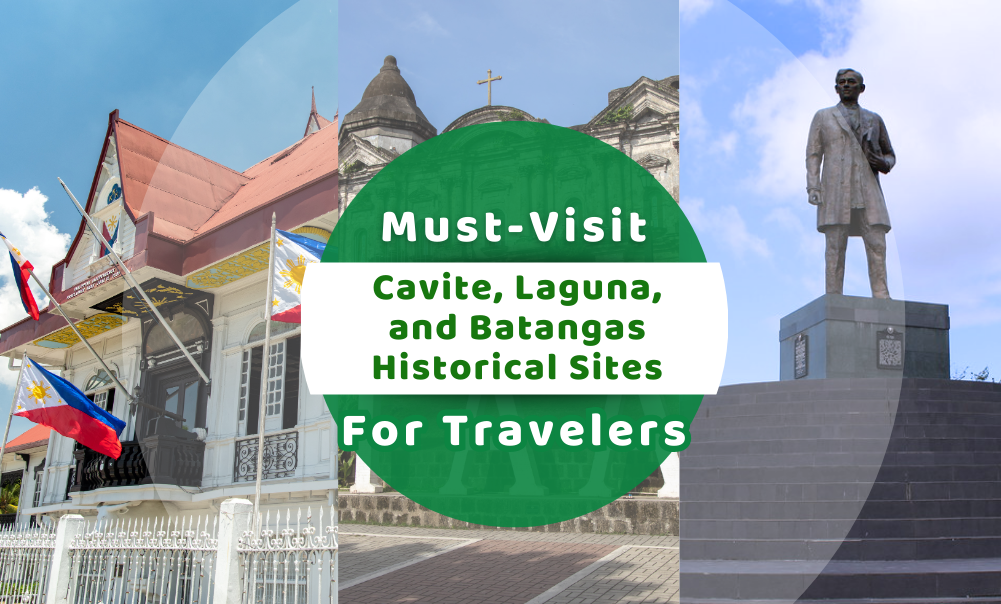The Philippines, an archipelago rich in cultural diversity and history, is home to countless historical landmarks that narrate the stories of its people and their past. Each monument, shrine, and historical site scattered across the islands is a silent witness to the lives, struggles, and aspirations of those who came before.
For travelers looking to delve deeper into the Philippines’ storied past, the provinces of Cavite, Laguna, and Batangas historical sites offer some of the most significant and well-preserved places. Whether you’re a history enthusiast or simply looking to enrich your travel experience, these destinations provide a unique glimpse into the heart of the country’s heritage.
Here are the best historical sites to visit in Cavite, Laguna, and Batangas in the Philippines:
9 Historical Places in Laguna, Cavite, and Batangas Worth Visiting
The birthplace of many of the country’s national heroes such the Philippines first president, Emilio Aguinaldo. This province played a crucial role in the country’s fight against Spanish colonization, being the home of many national heroes and the site of key events during the Philippine Revolution that have been turned into Cavite historical sites.
-
Bonifacio Trial House
This ancestral home, once belonging to Teodorico Reyes, holds a significant place in Philippine history as the site where Andres Bonifacio, the leader of the Katipunan, and his brother Procopio were tried for treason in May 1897.
The Cavite historical site has since been converted into a museum that vividly recreates the trial scene with life-sized statues, providing visitors with a poignant look at this crucial moment in history.
OPEN EXCEPT FOR MONDAYS:
8AM – 4PM
ENTRANCE FEE: ₱50
ADDRESS: Col. C. Riel, Maragondon, Cavite
-
Battle of Alapan Historical Marker
The Battle of Alapan was the site of the first significant military victory of the Filipino revolutionaries over the Spanish forces. This historical marker commemorates that triumph and also features a monument showcasing the evolution of the Philippine national flag, with the final design being held aloft by a woman. The marker is not just a reminder of the victory but also a celebration of national pride and unity.
ADDRESS: Imus Heritage Park, Cavite
-
Emilio Aguinaldo Shrine and Museum
The birthplace of Emilio Aguinaldo, the first president of the Philippines, this shrine and museum offers a comprehensive look at his life, from his childhood to his leadership during the revolution. This Cavite historical site is filled with personal memorabilia, including photographs, documents, and artifacts that shed light on Aguinaldo’s role in the struggle for independence.
OPEN EVERYDAY:
8AM – 4PM
DIRECTIONS:
- Get on a bus going to Kawit
- Tell the driver to drop you off directly at the Emilio Aguinaldo Shrine and Museum
LAGUNA:
Laguna, a province renowned for its natural beauty, is also steeped in history. It is the birthplace of the national hero, Jose Rizal. The province is dotted with historical sites that reflect its significant role in the nation’s past.
-
Magdalena Plaza
Built in 1882, Magdalena Plaza is a classic example of Spanish colonial architecture. One of the historical places in Laguna, with its well-preserved houses, offers a glimpse into what was once the standard for residential buildings during the Spanish era.
ADDRESS: IV A – Southern Tagalog, Magdalena, Laguna
-
Jose Rizal Shrine and Monument Plaza
This shrine is a tribute to Jose Rizal, the national hero who was born in Calamba, Laguna. The monument, erected on September 28, 1901, stands as a symbol of Rizal’s enduring legacy and his contributions to Philippine independence.
ADDRESS: Chipeco Ave, Calamba, Laguna
-
Nagcarlan Underground Cemetery
One of the interesting historical places in Laguna that was established in 1845 under the supervision of Franciscan priest Vicente Velloc, this underground cemetery is unique not just in Laguna but in the entire Philippines. Reserved initially for elite Catholic families, Spanish friars, and notable citizens, it is also believed to have served as a secret meeting place for Filipino revolutionaries.
OPEN EXCEPT FOR MONDAYS:
8AM – 4PM
DIRECTIONS:
- Take a bus going to San Pablo, Laguna
- At San Pablo ride a jeep going to Nagcarlan or Liliw, ask the driver to drop you off at the site
BATANGAS:
Batangas, a province known for its natural landscapes, beaches, and rich history, is home to many ancestral houses, churches, and historical landmarks. The province’s deep connection to its past is evident in its well-preserved sites.
-
Heritage Town of Taal
Established in 1572 by the Augustinian Order, it is one of the most well-preserved heritage towns in the Philippines. Walking through its streets, you’ll be transported back to the Spanish colonial era, with its collection of ancestral houses, churches, and other historical structures. Among the Batangas historical sites, this town is a living museum that offers a rare glimpse into the country’s past.
ADDRESS: Taal Municipal Building, Calle MM Agoncillo, Cor. Calle J.W. Diokno, Calle Marcela Mariño Agoncillo, Taal, Batangas
-
Cape Santiago Lighthouse
One of the oldest lighthouses in the Philippines, it is one of the Batangas historical sites that was built with the help of Spanish engineers and local landowners. Situated in Calatagan, this lighthouse not only served as a beacon for ships but also as a historical landmark that has stood the test of time.
DIRECTIONS:
- Take a bus going to Calatagan, Batangas
- From Calatagan, get a jeep or tricycle to take you all the way to the site
-
Casaysay Shrine and Saint Lucia Well
Located within Taal Heritage Town, the Casaysay Shrine is a place of both historical and religious significance. Near the shrine, you’ll find the San Lorenzo Ruiz Steps, which lead to Saint Lucia Well. This well is famous for the apparition of the Virgin Mary in the reflection of its waters, which locals believe have healing properties. The site, surrounded by lush greenery, continues to attract locals and tourists alike.
ADDRESS: Taal Heritage Town, Batangas
A Connected History Through Monuments
Despite the physical separation of these provinces, they share a common narrative—a story of struggle, resilience, and the enduring spirit of the Filipino people. By visiting these sites, travelers can get a glimpse into the country’s past and how it has shaped the present.
ALSO READ: Historical Sites and Landmarks in Iloilo that Should be in Your Itinerary
These monuments are living symbols of the nation’s heritage. As you explore these sites, take a moment to reflect on the stories they tell and the legacy they leave behind.
SuperCat Fast Ferry Corporation offers quick and comfortable rides around Batangas, Bacolod, Cebu, Iloilo, Ormoc, Calapan, and Tagbilaran. Contact us to help you find the best routes to the countries hidden gems today.


